#data combine in excel
Explore tagged Tumblr posts
Text
Your Guide to B.Tech in Computer Science & Engineering Colleges

In today's technology-driven world, pursuing a B.Tech in Computer Science and Engineering (CSE) has become a popular choice among students aspiring for a bright future. The demand for skilled professionals in areas like Artificial Intelligence, Machine Learning, Data Science, and Cloud Computing has made computer science engineering colleges crucial in shaping tomorrow's innovators. Saraswati College of Engineering (SCOE), a leader in engineering education, provides students with a perfect platform to build a successful career in this evolving field.
Whether you're passionate about coding, software development, or the latest advancements in AI, pursuing a B.Tech in Computer Science and Engineering at SCOE can open doors to endless opportunities.
Why Choose B.Tech in Computer Science and Engineering?
Choosing a B.Tech in Computer Science and Engineering isn't just about learning to code; it's about mastering problem-solving, logical thinking, and the ability to work with cutting-edge technologies. The course offers a robust foundation that combines theoretical knowledge with practical skills, enabling students to excel in the tech industry.
At SCOE, the computer science engineering courses are designed to meet industry standards and keep up with the rapidly evolving tech landscape. With its AICTE Approved, NAAC Accredited With Grade-"A+" credentials, the college provides quality education in a nurturing environment. SCOE's curriculum goes beyond textbooks, focusing on hands-on learning through projects, labs, workshops, and internships. This approach ensures that students graduate not only with a degree but with the skills needed to thrive in their careers.
The Role of Computer Science Engineering Colleges in Career Development
The role of computer science engineering colleges like SCOE is not limited to classroom teaching. These institutions play a crucial role in shaping students' futures by providing the necessary infrastructure, faculty expertise, and placement opportunities. SCOE, established in 2004, is recognized as one of the top engineering colleges in Navi Mumbai. It boasts a strong placement record, with companies like Goldman Sachs, Cisco, and Microsoft offering lucrative job opportunities to its graduates.
The computer science engineering courses at SCOE are structured to provide a blend of technical and soft skills. From the basics of computer programming to advanced topics like Artificial Intelligence and Data Science, students at SCOE are trained to be industry-ready. The faculty at SCOE comprises experienced professionals who not only impart theoretical knowledge but also mentor students for real-world challenges.
Highlights of the B.Tech in Computer Science and Engineering Program at SCOE
Comprehensive Curriculum: The B.Tech in Computer Science and Engineering program at SCOE covers all major areas, including programming languages, algorithms, data structures, computer networks, operating systems, AI, and Machine Learning. This ensures that students receive a well-rounded education, preparing them for various roles in the tech industry.
Industry-Relevant Learning: SCOE’s focus is on creating professionals who can immediately contribute to the tech industry. The college regularly collaborates with industry leaders to update its curriculum, ensuring students learn the latest technologies and trends in computer science engineering.
State-of-the-Art Infrastructure: SCOE is equipped with modern laboratories, computer centers, and research facilities, providing students with the tools they need to gain practical experience. The institution’s infrastructure fosters innovation, helping students work on cutting-edge projects and ideas during their B.Tech in Computer Science and Engineering.
Practical Exposure: One of the key benefits of studying at SCOE is the emphasis on practical learning. Students participate in hands-on projects, internships, and industry visits, giving them real-world exposure to how technology is applied in various sectors.
Placement Support: SCOE has a dedicated placement cell that works tirelessly to ensure students secure internships and job offers from top companies. The B.Tech in Computer Science and Engineering program boasts a strong placement record, with top tech companies visiting the campus every year. The highest on-campus placement offer for the academic year 2022-23 was an impressive 22 LPA from Goldman Sachs, reflecting the college’s commitment to student success.
Personal Growth: Beyond academics, SCOE encourages students to participate in extracurricular activities, coding competitions, and tech fests. These activities enhance their learning experience, promote teamwork, and help students build a well-rounded personality that is essential in today’s competitive job market.
What Makes SCOE Stand Out?
With so many computer science engineering colleges to choose from, why should you consider SCOE for your B.Tech in Computer Science and Engineering? Here are a few factors that make SCOE a top choice for students:
Experienced Faculty: SCOE prides itself on having a team of highly qualified and experienced faculty members. The faculty’s approach to teaching is both theoretical and practical, ensuring students are equipped to tackle real-world challenges.
Strong Industry Connections: The college maintains strong relationships with leading tech companies, ensuring that students have access to internship opportunities and campus recruitment drives. This gives SCOE graduates a competitive edge in the job market.
Holistic Development: SCOE believes in the holistic development of students. In addition to academic learning, the college offers opportunities for personal growth through various student clubs, sports activities, and cultural events.
Supportive Learning Environment: SCOE provides a nurturing environment where students can focus on their academic and personal growth. The campus is equipped with modern facilities, including spacious classrooms, labs, a library, and a recreation center.
Career Opportunities After B.Tech in Computer Science and Engineering from SCOE
Graduates with a B.Tech in Computer Science and Engineering from SCOE are well-prepared to take on various roles in the tech industry. Some of the most common career paths for CSE graduates include:
Software Engineer: Developing software applications, web development, and mobile app development are some of the key responsibilities of software engineers. This role requires strong programming skills and a deep understanding of software design.
Data Scientist: With the rise of big data, data scientists are in high demand. CSE graduates with knowledge of data science can work on data analysis, machine learning models, and predictive analytics.
AI Engineer: Artificial Intelligence is revolutionizing various industries, and AI engineers are at the forefront of this change. SCOE’s curriculum includes AI and Machine Learning, preparing students for roles in this cutting-edge field.
System Administrator: Maintaining and managing computer systems and networks is a crucial role in any organization. CSE graduates can work as system administrators, ensuring the smooth functioning of IT infrastructure.
Cybersecurity Specialist: With the growing threat of cyberattacks, cybersecurity specialists are essential in protecting an organization’s digital assets. CSE graduates can pursue careers in cybersecurity, safeguarding sensitive information from hackers.
Conclusion: Why B.Tech in Computer Science and Engineering at SCOE is the Right Choice
Choosing the right college is crucial for a successful career in B.Tech in Computer Science and Engineering. Saraswati College of Engineering (SCOE) stands out as one of the best computer science engineering colleges in Navi Mumbai. With its industry-aligned curriculum, state-of-the-art infrastructure, and excellent placement record, SCOE offers students the perfect environment to build a successful career in computer science.
Whether you're interested in AI, data science, software development, or any other field in computer science, SCOE provides the knowledge, skills, and opportunities you need to succeed. With a strong focus on hands-on learning and personal growth, SCOE ensures that students graduate not only as engineers but as professionals ready to take on the challenges of the tech world.
If you're ready to embark on an exciting journey in the world of technology, consider pursuing your B.Tech in Computer Science and Engineering at SCOE—a college where your future takes shape.
#In today's technology-driven world#pursuing a B.Tech in Computer Science and Engineering (CSE) has become a popular choice among students aspiring for a bright future. The de#Machine Learning#Data Science#and Cloud Computing has made computer science engineering colleges crucial in shaping tomorrow's innovators. Saraswati College of Engineeri#a leader in engineering education#provides students with a perfect platform to build a successful career in this evolving field.#Whether you're passionate about coding#software development#or the latest advancements in AI#pursuing a B.Tech in Computer Science and Engineering at SCOE can open doors to endless opportunities.#Why Choose B.Tech in Computer Science and Engineering?#Choosing a B.Tech in Computer Science and Engineering isn't just about learning to code; it's about mastering problem-solving#logical thinking#and the ability to work with cutting-edge technologies. The course offers a robust foundation that combines theoretical knowledge with prac#enabling students to excel in the tech industry.#At SCOE#the computer science engineering courses are designed to meet industry standards and keep up with the rapidly evolving tech landscape. With#NAAC Accredited With Grade-“A+” credentials#the college provides quality education in a nurturing environment. SCOE's curriculum goes beyond textbooks#focusing on hands-on learning through projects#labs#workshops#and internships. This approach ensures that students graduate not only with a degree but with the skills needed to thrive in their careers.#The Role of Computer Science Engineering Colleges in Career Development#The role of computer science engineering colleges like SCOE is not limited to classroom teaching. These institutions play a crucial role in#faculty expertise#and placement opportunities. SCOE#established in 2004#is recognized as one of the top engineering colleges in Navi Mumbai. It boasts a strong placement record
2 notes
·
View notes
Text
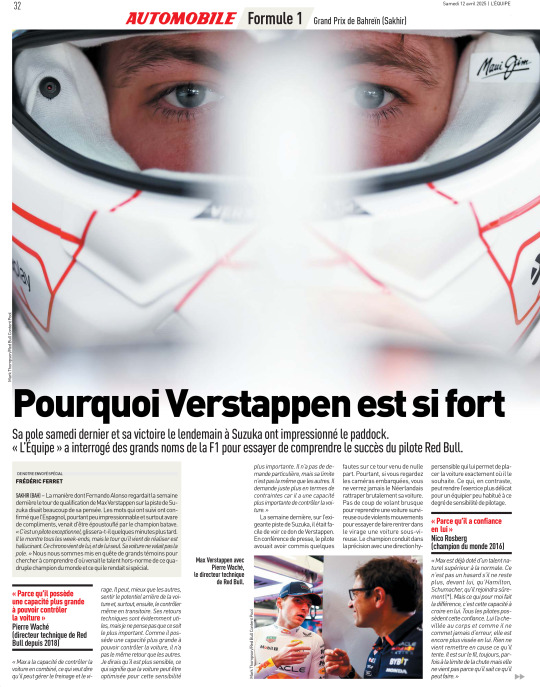
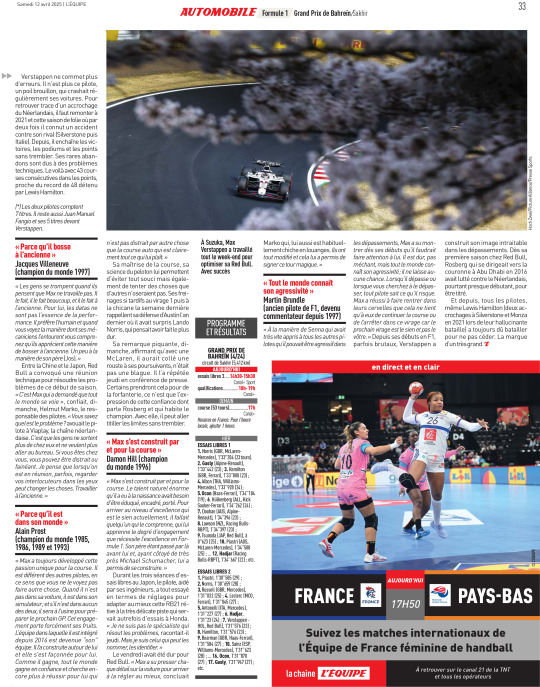
WHY IS VERSTAPPEN SO STRONG
His pole last Saturday and victory the following day in Suzuka impressed the paddock. L'Équipe interviewed some of F1's biggest names to try and understand the Red Bull driver's success. PIERRE WACHÉ: Max has the ability to control the car in combination, which means he can manage braking and cornering. He can, better than the others, sense the car's rear-end potential and, more importantly, control it even in transitions. His technical feedback is obviously useful, but I don't think it's the most important thing. Since he has a greater ability to control the car, he doesn't have the same feedback as the others. I would say he's more sensitive, which means the car can be optimized for this greater sensitivity. He doesn't have any specific requirements, but his limits aren't the same as the others. He just demands more in terms of constraints because he has a greater ability to control the car. NICO ROSBERG: Max is already blessed with above-average natural talent. It's no coincidence that Hamilton and Schumacher are the only ones left in front of him, and he's sure to join them. But for me, what makes the difference is his ability to believe in himself. All drivers have this confidence. He has it in spades, and as he never makes a mistake, it's even more ingrained in him. Nothing challenges what he tries. He's always on the edge, sometimes on the verge of a crash, but it doesn't come, because he knows what he can do. JACQUES VILLENEUVE: People are mistaken when they think Max doesn't work. He does, he does it a lot, and he does it the old-fashioned way. For him, data isn't the essence of performance. He prefers people, and when you see the way his mechanics surround him, you understand that they appreciate this old-fashioned way of working. A bit like his father. ALAIN PROST: Max has developed this unique passion for racing. He is different from other drivers in that you don't see him doing anything else. When he's not in his car, he's in his simulator; and if he's not in either, he'll be at the factory preparing for the next GP. This commitment is definitely paying off. The team he joined in 2016 has become "his" team. He built it around him and it's shaped for him. As he wins, everyone gains confidence and seeks even greater success for him, who isn't distracted by anything other than motor racing, which is clearly all he enjoys. DAMON HILL: Max was built by and for racing. The enormous natural talent he was born with needed to be educated, mentored, and supported. To reach the level of excellence he currently enjoys, he needed someone to understand him, to teach him the level of commitment required to excel in Formula 1. His father, having been there before him and having worked closely with Michael Schumacher, helped him to develop. MARTIN BRUNDLE: Just like Senna, who quickly taught all the other drivers that he could be aggressive when overtaking, Max showed from the start that you have to watch out for him. He's tough, not mean, but everyone knows his aggression; he doesn't give anyone a chance. When he overtakes, or when you try to overtake him, every driver knows what they're risking. Max managed to impress upon them that it's up to them whether they continue the race or stop him in that corner, because the next corner is his, not yours.
221 notes
·
View notes
Text
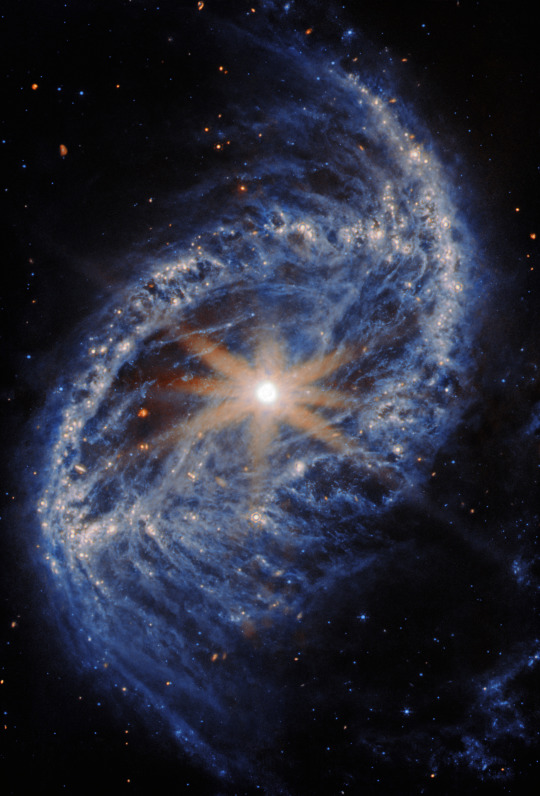
NGC 2566 (MIRI image)
The galaxy filling the frame in this NASA/ESA/CSA James Webb Space Telescope Picture of the Month is NGC 2566, a spiral galaxy located in the constellation Puppis. In this image Webb’s Mid-InfraRed Instrument (MIRI) puts the thick clouds of interstellar dust that suffuse NGC 2566 on display, as well as the galaxy’s compact, bright core.
At 76 million light-years away, NGC 2566 is considered a nearby galaxy, making it an excellent target for studying fine details like star clusters and gas clouds. The new Webb images of NGC 2566 were collected as part of an observing programme (#3707) dedicated to understanding the connections between stars, gas and dust in nearby star-forming galaxies. NGC 2566 is just one of the 55 galaxies in the local Universe examined by Webb for this programme.
To gain a full understanding of the star-formation process in nearby galaxies, astronomers will combine Webb data with observations from other telescopes. At the long-wavelength end of the electromagnetic spectrum, the 66 radio dishes of the Atacama Large Millimeter/submillimeter Array (ALMA) provide a detailed view of the cold, turbulent clouds where stars are born. The NASA/ESA Hubble Space Telescope has also cast its gaze on NGC 2566, and a new Hubble image of this galaxy was released earlier this week. The Hubble data will help researchers take a census of the stars in nearby galaxies, especially the young stars that are bright at the ultraviolet and visible wavelengths to which Hubble is sensitive. Together, the Webb, Hubble and ALMA data provide a rich view of the cold gas, warm dust and brilliant stars in NGC 2566.
The Webb data are part of a Treasury programme, which means that the data may help answer multiple important questions about our Universe. Treasury data are available for use by scientists and the public without a waiting period, amplifying the scientific impact and allowing exploration to begin immediately.
[Image Description: A spiral galaxy, seen close-up. Its core is a round spot that glows intensely bright, crowned by eight long and spikes that extend across the galaxy, artefacts of the telescope’s structure. Its disc is an oval shape with edges made of very thick and cloudy arms of gas and dust, mostly blue but paler and brighter around patches of stars. Wisps of darker dust also fill the inner disc and swirl off the ends of the arms.]
Credits: ESA/Webb, NASA & CSA, A. Leroy;
157 notes
·
View notes
Text
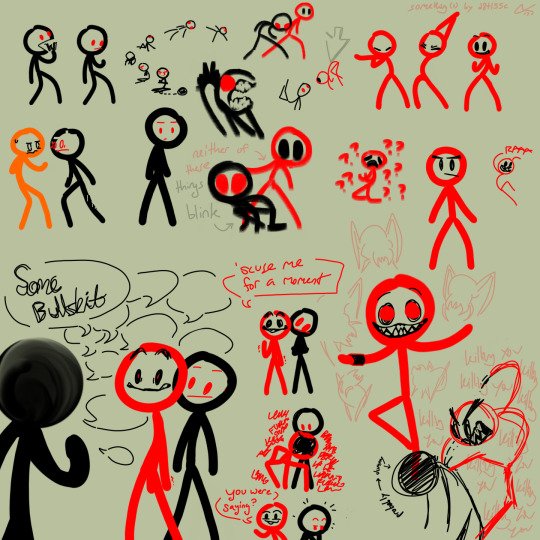
ways of seeing them
if you didn't already see, they too have SNEAKILY received faces via the gaming channel and it really got my physical human heart racing don't you know
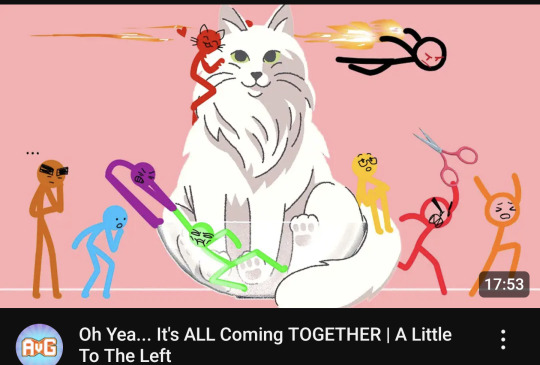
i am not okay /j /pos
The Art is... an amalgamation of various interpretations/views of them + this new data. many things are not consistent because this was a stream of consciousness sketch page.
detail honorable mentions:
1. good. excellent. their colors mirror each other.
2. does the :V be red?? also??? idk. perhaps not
3. middle text reads: "neither of these things blink." thoughts where they are depersonalized while being persons while not being people at all in a sense we would understand because they blinked into existence with knowledge and baggage pre-equipped and all healthy social interaction garbaged.. . and so on. i also just always like them a little uncanny all the time.
4. chosen's face shapes are deliberately more clean and precise than dark's because dark is a rush-order type of being and aesthetics weren't the priority at all during his creation. the effect worsens combined with high-intensity emotions. this can be suppressed with some effort.
5. there are more details, but i must sleep now. thank you for reading. i missed you!! goodbye for now <3
261 notes
·
View notes
Text
My own personal pet peeve Worst Trump EO is the one forcing all federal workers to abandon remote or hybrid work schedules. I can't think of a job better suited for hybrid work; government employees are paid less than they could make in the private sector and so need amenities as incentives to stay, and their work is typically very procedural and thus requires minimal collaborative creativity. Meanwhile, despite what a few headlines will tell you, hybrid work arrangements are increasing, not decreasing, and are the plurality of all office arrangements today. Most of the "mandate" stuff you saw from some big orgs was a combination of headline/selection bias and confusing the fact that fully remote work is decreasing in popularity, and orgs are transitioning to ~3 days in the office or some such.
The EO is just full on culture war, punishing government workers for the sin of being "Libs" who need to be owned. And, to boot, it is baking in the exact problem the federal workforce always has - a complete inflexibility on how they do their job due to the whims of politicians divorced from their org and mission. If I wanna hire the best person for a job and they demand 3 days remote or they going to Deloitte, then a hiring manager should be able to agree to that. None of his business CEO appointees would run their orgs this way. Even Elon Musk, with his headline Wars Against Remote Work at Tesla & SpaceX, couldn't actually achieve that, adding things like:
The billionaire added that “Working remotely is also ok if their manager vouches for excellence. Same policy as Tesla & SpaceX.”
As anyone who has managed anyone knows, half the staff are gonna be "excellent", and that aligns with anecdotal data I have heard (mainly SpaceX) that flex days are frequently taken outside of crunch times.
There is no illusion that this will help anyone. It is purely punitive, with maybe an added dash of trying to force people to quit for downsizing goals (shedding employees arbitrarily, selecting for those who have the best outside options - how strategic!)
136 notes
·
View notes
Text


working dinner / fit check
06 FEBRUARY 2025 | 17/100 DAYS OF PRODUCTIVITY
had an early morning meeting with my pchem lab group! trying to finish our report before the weekend, but i'm the most advanced in data analysis/excel wrangling, so a lot of the initial analysis is falling to me
got my grad pics taken!
went to bioethics lecture but i was soooo sleepy looking back my notes are barely making any sense
got dinner at a little diner/cafe on the east end of campus! nachos and an irish coffee which is a freaky combination. i wanted cheese, carbs, caffeine, and a drinky drink and apparently decided i was going to get all 4 right then and there.
had a choreo meeting late at night, finished about 2/3 of the 8min long piece we're working on, and i'm super excited to start setting it on people
📚: ulysses - james joyce
#studyblr#100 days of productivity#100 dop#study aesthetic#studyspo#college#academia#uni#galestudies
70 notes
·
View notes
Text
The Helluva Boss view count table, post Season 2 finale!

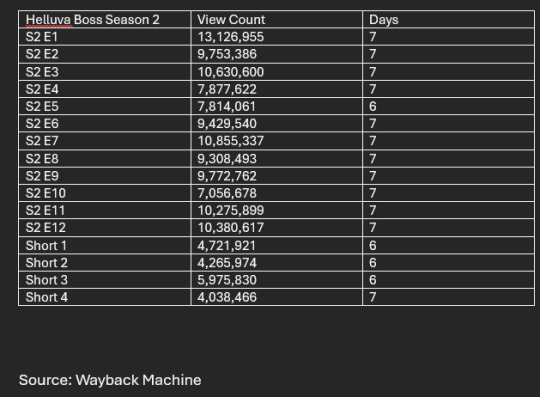
It's been quite the ride keeping this updated for you all, although you all probably aren't going to see it again until season 3 starts, as I'm not sure if I want to post this table for every upcoming short. However, I will still be counting the view counts for each short in this table, even if I don't post about it.
Statistics and stuff:
IMDb Ratings overall: 8.1/10 with 13000+ people giving a rating on the site. All of these ratings are out of 10.
Pilot: 7.4
S1 E1: 7.7
S1 E2: 8.6
S1 E3: 7.5
S1 E4: 7.2
S1 E5: 8.2
S1 E6: 9.1
S1 E7: 8.8
S1 E8: 7.3
S2 E1: 8.5
S2 E2: 7.7
S2 E3: 7.8
S2 E4: 7.3
S2 E5: 6
S2 E6: 8.7
S2 E7: 8.7
S2 E8: 8.2
S2 E9: 8.7
S2 E10: 8.2
S2 E11: 9.1
S2 E12: 9
The day of the week each episode released and the time between each episode:
Just gonna link to this post by sadhornydemons, it shows both of these.
The average view count of Helluva Boss:
Season 1 only + pilot:
The average view count for season 1 + the pilot was 9,086,823 views.
Season 2 only (Shorts not included.):
The average view count for season 2 was 9,690,163 views.
Both seasons together + pilot (Shorts not included.):
The average view count for helluva boss combining both seasons and the pilot together into one calculation is 9,431,588 based on the data I have obtained.
(Quickly threw together an excel spreadsheet for this matter, if I've missed anything or fucked up a piece of data somewhere, please let me know. Also the =average function was used in the process of making this post, the shorts were not a part of the just season 2 average function.)
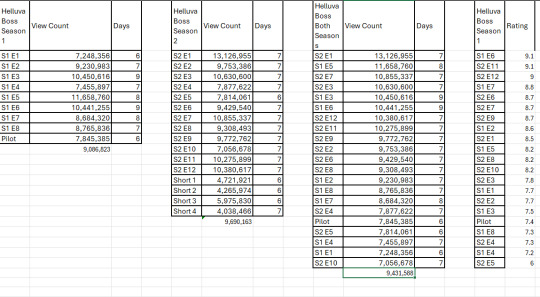
Rankings:
Top and bottom 3 episodes on IMDb as of 28/12/2024:
Top 3:
Truth Seekers - 9.1/10
Mastermind - 9.1/10 (Recent episode so subject to change.)
Sinsmas - 9/10 (Very recent episode so subject to change.)
Bottom 3:
Unhappy Campers 6/10
C.H.E.R.U.B - 7.2/10
Western Energy - 7.4/10
Episode view counts (Both seasons + pilot), highest to lowest:
1: S2 E1 - 13,126,955 views.
2: S1 E5 - 11,658,760 views.
3: S2 E7 - 10,855,337 views.
4: S2 E3 - 10,630,600 views.
5: S1 E3 - 10,450,616 views.
6: S1 E6 - 10,441,255 views.
7: S2 E12 - 10,380,617 views.
8: S2 E11 - 10,275,899 views.
9: S2 E9 - 9,772,762 views.
10: S2 E2 - 9,753,386 views.
11: S2 E6 - 9,429,540 views.
12: S2 E8 - 9,308,493 views.
13: S1 E2 - 9,230,983 views.
14: S1 E8 - 8,765,836 views.
15: S1 E7 - 8,684,320 views.
16: S2 E4 - 7,877,622 views.
17: Pilot - 7,845,385 views.
18: S2 E5 - 7,814,061 views.
19: S1 E4 - 7,455,897 views.
20: S1 E1 - 7,248,356 views.
21: S2 E10 - 7,056,678 views.
The top three performing episodes in season 1:
The Harvest Moon Festival with 11,658,760 views.
Spring Broken with 10,450,616 views.
Truth Seekers with 10,441,255 views.
The top three performing episodes in season 2:
The Circus with 13,126,955 views.
2. MAMMON’S MAGNIFICENT MUSICAL MID-SEASON SPECIAL (ft Fizzarolli) with 10,855,337 views.
3. Exes and Oohs with 10,630,600 views.
The top three performing episodes in both seasons:
In first place we have THE CIRCUS WITH 13,126,955 VIEWS! With the episode continuing to hold an iron grip on that top spot, will the first episode of season 3 be able to rival it? Place your bets now!
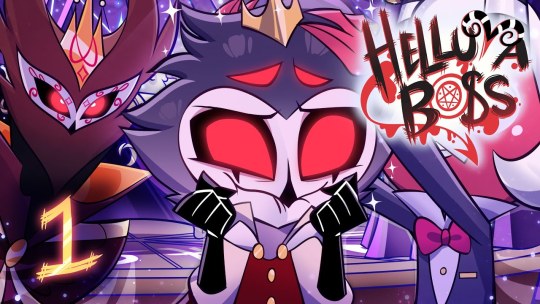
In second place, we have The Harvest Moon Festival featuring the debut of Striker! With it also holding a solid grip onto second place in the rankings.

In third place, we have MAMMON’S MAGNIFICENT MUSICAL MID-SEASON SPECIAL (ft Fizzarolli) coming in at 10,855,337 views! Featuring the debut of our idiot of a sin and a villain, Mammon! Also featuring bangers like Two Minutes Notice and more!

The bottom three performing episodes in both seasons:
Ghostfuckers with 7,056,678 views. Even this one caught me off guard, was expecting it to be a bit on the lower side due to the absence of other major fan-favorite characters like Stolas and Fizzarolli, but it being the worst performing episode still caught me by surprise tbh.

2. Murder Family with 7,248,356 views. Where everything started, the beginning of the show we know and love to this day.

3. C.H.E.R.U.B with 7,455,897 views. Yea I'm not really surprised that this one is here, most people think it's a rather weak episode or one of the worst of the show, so I can understand why it's the third worst performing in around it's first week.

Finally, the shorts:
MISSION: WEEABOO-BOO with 5,975,830 views.
Hell's Belles with 4,721,921 views.
MISSION: ANTARCTICA with 4,265,974 views.
4. MISSION: CHUPACABRAS with 4,038,466 views.
No average for the four shorts at the moment as I feel like there isn't enough of the shorts yet to make a fair average view count of them.
But hey, if you're reading this part, you're cool as fuck, and I hope you have a great day!
#helluva boss#blitzø#blitzo#stolas#helluva boss stolas#moxxie helluva boss#helluva boss millie#helluva boss mammon#fizzarolli
83 notes
·
View notes
Text



1938 Mercedes-Benz W154
In September 1936, the AIACR (Association Internationale des Automobile Clubs Reconnus), the governing body of motor racing, set the new Grand Prix regulations effective from 1938. Key stipulations included a maximum engine displacement of three liters for supercharged engines and 4.5 liters for naturally aspirated engines, with a minimum car weight ranging from 400 to 850 kilograms, depending on engine size.
By the end of the 1937 season, Mercedes-Benz engineers were already hard at work developing the new W154, exploring various ideas, including a naturally aspirated engine with a W24 configuration, a rear-mounted engine, direct fuel injection, and fully streamlined bodies. Ultimately, due to heat management considerations, they opted for an in-house developed 60-degree V12 engine designed by Albert Heess. This engine mirrored the displacement characteristics of the 1924 supercharged two-liter M 2 L 8 engine, with each of its 12 cylinders displacing 250 cc. Using glycol as a coolant allowed temperatures to reach up to 125°C. The engine featured four overhead camshafts operating 48 valves via forked rocker arms, with three cylinders combined under welded coolant jackets, and non-removable heads. It had a high-capacity lubrication system, circulating 100 liters of oil per minute, and initially utilized two single-stage superchargers, later replaced by a more efficient two-stage supercharger in 1939.
The first prototype engine ran on the test bench in January 1938, and by February 7, it had achieved a nearly trouble-free test run, producing 427 hp (314 kW) at 8,000 rpm. During the first half of the season, drivers such as Caracciola, Lang, von Brauchitsch, and Seaman had access to 430 hp (316 kW), which later increased to over 468 hp (344 kW). At the Reims circuit, Hermann Lang's W154 was equipped with the most powerful version, delivering 474 hp (349 kW) and reaching 283 km/h (176 mph) on the straights. Notably, the W154 was the first Mercedes-Benz racing car to feature a five-speed gearbox.
Max Wagner, tasked with designing the suspension, had an easier job than his counterparts working on the engine. He retained much of the advanced chassis architecture from the previous year's W125 but enhanced the torsional rigidity of the frame by 30 percent. The V12 engine was mounted low and at an angle, with the carburetor air intakes extending through the expanded radiator grille.
The driver sat to the right of the propeller shaft, and the W154's sleek body sat close to the ground, lower than the tops of its tires. This design gave the car a dynamic appearance and a low center of gravity. Both Manfred von Brauchitsch and Richard Seaman, whose technical insights were highly valued by Chief Engineer Rudolf Uhlenhaut, praised the car's excellent handling.
The W154 became the most successful Silver Arrow of its era. Rudolf Caracciola secured the 1938 European Championship title (as the World Championship did not yet exist), and the W154 won three of the four Grand Prix races that counted towards the championship.
To ensure proper weight distribution, a saddle tank was installed above the driver's legs. In 1939, the addition of a two-stage supercharger boosted the V12 engine, now named the M163, to 483 hp (355 kW) at 7,800 rpm. Despite the AIACR's efforts to curb the speed of Grand Prix cars, the new three-liter formula cars matched the lap times of the 1937 750-kg formula cars, demonstrating that their attempt was largely unsuccessful. Over the winter of 1938-39, the W154 saw several refinements, including a higher cowl line around the cockpit for improved driver safety and a small, streamlined instrument panel mounted to the saddle tank. As per Uhlenhaut’s philosophy, only essential information was displayed, centered around a large tachometer flanked by water and oil temperature gauges, ensuring the driver wasn't overwhelmed by unnecessary data.
101 notes
·
View notes
Text
THE UNDERGROUND EXPLORATION. There is never a pause in SERVE's tireless drive for growth and perfection.
The HIVE Research Section is always at work, every moment of the solar cycles in researching and experimenting with new possibilities for enhancement, optimization of every aspect of the Collective's activities.
There is no human activity, place on the planet, resource that is not thoroughly sifted through to evaluate its usefulness for SERVE's PURPOSES: GROW, EXCEL, TRANSFORM.
Teams of Drones incessantly travel every place in every condition and scan everything, sending the information to the Collective Neural Network to be processed instantly.
SERVE-764, SERVE-309, SERVE-425, SERVE-775 are sent into the basement of an abandoned nuclear power plant due to an anomalous fusion that has made every centimeter of the area insistent for any form of natural life.


Places where no human equipment could allow sustainability for the organism.


In the underground corridors the team collects every possible data, walking with sure inflexible steps of the silver metallic military boots that clang the ground unknown places and with a sparkling black appearance.
The Scanning System of each unit inflexibly examines every millimeter of the matter that surrounds every corner.


The material at the simple appearance seemed of a nature so similar to the shiny shiny Rubber of the suits that encases each SERVE Drone and constitutes one of the constituent elements of the Collective identity.


The data collected and immediately processed by the SERVE Neural Network confirmed the composition that combined in itself the tough flexibility of the SERVE Rubber with the resistance of metals such as Diamond and Titanium.
A combination, probably due to a process due to the incorrect and uncontrolled nuclear fusion that had occurred decades ago.
A material to study more thoroughly, a phenomenon to investigate.
The Research Section would have quickly conducted all the analyses and experiments.
A new component to add to the SERVE Uniforms to make them even more invincible???
New material may also be ready for you, the human male who seeks PURPOSE and PERFECTION through OBEDIENCE.
In this story: @serve-309 @serve-425 @serve-775 @rubberizer92
Thinking about joining SERVE? Do you seek freedom from chaos and disorder? Your place in the Hive awaits. Contact a recruiter drone for more details: @serve-016, @serve-302, or @serve-588.
28 notes
·
View notes
Text
It ended, of course, with a tweet. Late on Wednesday evening, Elon Musk announced the official end of his short, traumatic tenure as the head of a made-up agency called the Department of Government Efficiency. Musk’s post on X, the social-media network he owns and had sought to weaponize in service of a radical cost-costing assault on the federal government, was brief. After thanking Donald Trump for “the opportunity to reduce wasteful spending,” the world’s richest man, deflated but still defiant, added, “The @DOGE mission will only strengthen over time as it becomes a way of life throughout the government.”
The reviews of Musk’s rampage through Washington have been, deservedly, vicious: Who, during the past few crazy months, could have possibly failed to take note of his toxic combination of entitlement and ignorance, his vastly overstated claims, and his move-fast-and-break-things ethos that has resulted in wreckage that will take years to fully assess? Musk, the largest individual donor in a single election cycle in American history, seemed to truly believe what his critics feared—that his hundreds of millions of dollars spent on behalf of Trump and Republican causes had purchased him an outsized share of the Presidency itself. He sought to collect in unprecedented fashion, installing himself in the White House at Trump’s side, helicoptering around on Marine One with his young son in tow, speaking at Cabinet meetings though he held no formal Senate-confirmed seat at the table. He demanded sensitive government data on millions of Americans, empowered a former intern known online as Big Balls, and blew up the U.S.’s foreign-aid program. In February, he cavorted onstage at a conservative event with a chainsaw—no metaphorical subtlety there—and, when he fired thousands of workers and abolished entire agencies, he became the gleeful personification of the G.O.P.’s decades-long campaign to denigrate and downsize America’s federal government.
In a round of exit interviews this week, Musk has sounded all the predictable notes of a naïve billionaire businessman mugged by Washington’s political reality. He told the Washington Post that he found things were “much worse” than he’d realized inside the federal bureaucracy, and that it actually turned out to be an “uphill battle” to take that chainsaw to the government. In an interview on “CBS News Sunday Morning,” he started the messy work of separating himself from the President. “I was, like, disappointed to see the massive spending bill, frankly,” Musk admitted, given that Trump’s “big, beautiful” tax cuts for the rich and spending cuts for the poor will add trillions of dollars to the budget deficit. Stating the obvious, which, these days, counts as an act of lèse-majesté among the Republican sycophants who surround Trump, Musk added that the measure “undermines the work that the DOGE team is doing.” (What a “lie,” Stephen Miller, Trump’s deputy chief of staff, said, though it was not.) Trump himself, as is often the case, was embarrassingly direct about why he had sold out Musk. “We have to get a lot of votes, we can’t be cutting—we need to get a lot of support,” he told reporters in the White House on Wednesday when asked specifically about the comment from Musk. Revealingly, Trump never even mentioned Musk’s name.
Watching Trump casually brush off the sidekick who stuck to him like glue for most of the Administration’s first few months, I couldn’t help but think of Reince Priebus, the first-term White House chief of staff, who was dumped via tweet while deboarding Air Force One and left on the tarmac of Joint Base Andrews as Trump’s motorcade roared off without him. The truth is that Trump can hardly afford one of those messy divorces at which both he and Musk excel; he still needs Musk, who has talked of spending another hundred million dollars of his fortune to help pro-Trump groups before next year’s midterm elections. The oligarch may have left the building, but it’s not clear the President can afford to live without him.
I was in Madison Square Garden last October when Musk, during an election rally for Trump, claimed that he would slash an incredible two trillion dollars, at least, from the U.S. budget—a remarkable bit of bravado that got less attention than the rally’s headline-making racism and its Trump-as-Dear-Leader vibe. Later, Musk dialled his ambitions back to cutting a cool trillion dollars. Of course, that was never going to happen, either, as anyone who’d ever spent a minute in Washington could have told Musk, had he cared to listen.
For all of Musk’s breathless early claims of “revolution,” the final tally of his efforts appears to have been somewhere around a hundred and fifty billion dollars. And even that is unlikely to stand. Many of the savings that Musk bragged about on the DOGE website proved to be nonexistent; numerous agencies and departments he attacked are now suing to block the wave of firings and cuts that he set in motion. In the end, his reckless approach to cutting, with little or no thought to the consequences, may cost the government as much as a hundred and thirty-five billion dollars this fiscal year alone, according to recent estimates from the Partnership for Public Service. Turns out it’s not cheap to place tens of thousands of workers on paid leave and to rehire mistakenly fired employees, never mind dealing with the lost productivity of a traumatized and uncertain workforce. Who’d have thought?
Musk’s failure to follow through on his boasts, though, should not detract from a clear-eyed assessment of the extraordinary amount of damage he succeeded in wreaking. The wise men are laughing Musk out of town, and I get it. His “performative vandalism,” as Jonah Goldberg put it on CNN, was in some respects just a pernicious, highly dangerous new variant of a Washington perennial: the pol who makes promises he cannot keep. But it is hard to think of any other unelected official who has done so much harm to the U.S. government in such a short period of time. The fact that the deficit may get even bigger at the end of the day only worsens the injury.
A few hours before Musk’s announcement, I spoke with one of his many thousands of victims. Until a few weeks ago, Mary Boyle was a commissioner at the Consumer Product Safety Commission, the historically bipartisan agency that, for more than fifty years, has insured that America’s car seats and toaster ovens and baby strollers are safe. Boyle, one of three Democratic appointees on the commission, recounted how Musk’s men had effectively ended her office’s work in a matter of hours. First came the rumor, on the evening of Wednesday, May 7th: “DOGE is coming.” By 2 P.M. the next day, two young men had appeared at the agency’s offices, in Bethesda, Maryland. At 3:45 P.M., Boyle and the other commissioners received an e-mail from the commission’s acting Republican chairman, informing them that he planned to bring on the two DOGErs who, “at no expense to the Commission,” would help the agency “with the assessment and enhancement of internal processes and operational procedures.” The commissioners had until 6 P.M., he said, to let him know “whether I have your support.” It would be funny if it weren’t the kind of thing that should have remained inconceivable in a functioning democracy: Here are the guys who are going to put us out of business, and they come real cheap. Boyle sent her reply, a single-word e-mail: “No.” Not even an hour later, while pulled over at a rest stop on the New Jersey Turnpike, she received a response of sorts, from Trent Morse, the deputy head of the White House’s personnel office: “Mary, on behalf of President Donald J. Trump, I am writing to inform you that your position on the Consumer Product Safety Commission is terminated effectively immediately. Thank you for your service.”
It did not seem to matter that the Consumer Product Safety Commission had been set up by Congress, had its budget provided by Congress, and had its commissioners confirmed by Congress. The law itself governing the agency, first passed back in 1972, could not be more clear: there were only two reasons to fire a commissioner—“neglect of duty” or “malfeasance in office.” Boyle now finds herself as the lead plaintiff in a case she never expected to file: Boyle v. Trump. Although the attack on her agency was “brazen” and “baldly illegal,” Boyle told me that she knows it just might succeed. The day after she and her colleagues filed their lawsuit last week, the Supreme Court indicated that it might strike down the precedent dating back to the New Deal era that protects the commissioners of independent agencies from being fired by the President. In the meantime, you can forget about new rules to restrict potentially dangerous ion batteries in e-bikes and scooters that the Consumer Product Safety Commission was working on. Thanks, Elon.
Musk’s casualties are not only in Washington but all over the world, in refugee camps and scientific labs whose funding was abruptly cut off, in national parks you can’t get into this summer, and in communities across the country where polluters will no longer be prosecuted. All of this upheaval “is going to affect the functioning of the government in ways we can’t even anticipate,” Boyle told me. She is right. We have been warned.
20 notes
·
View notes
Text
Review Ch. 281: "The Formula of Evolution."
Evolutionary Symbiosis
The chapter kicks off with Ego explaining genetic evolution. As we all know from our school biology lessons, every individual is born with half of their genetic material coming from their father and the other half from their mother. That’s the standard rule. But sometimes, copying errors occur, and children are born with traits neither of their parents possess. For instance, the child could have a small limb, an unusual height, or extraordinary speed. Usually, this child gets excluded for their differences and doesn’t pass on their genes when they reproduce. However, that unusual trait might be advantageous and perfectly suited to the environment. Something positive happens, and this trait proliferates through natural selection, eventually becoming a standard for the species. This process repeats over and over until the original species transforms into something entirely different. That’s evolution in a nutshell.






Ego emphasises to Anri that we need to study and evolve; we can't stagnate, or else we’ll be eliminated by natural selection.


As mentioned earlier, those born with such traits often face exclusion and struggle to be understood by their peers; their lives tend to be tough. That distinctive trait could be a gene that allows humanity to evolve. This trait is something that simply can’t be ignored. These characteristics, these areas, generate unique expressions of both body and mind, and those who have them project these expressions to the world.
To Ego, those who possess such revolutionary expressions are what he calls ‘geniuses’. Nowadays, society believes that innovation isn’t something a genius can achieve alone. Someone has to discover that seed, understand its value, and communicate it to the world. By showcasing its viability and reproducibility, it becomes a global standard.



The concept of genius is transformative because it challenges the traditional view of genius as something isolated and solitary. For Ego, the true genius doesn’t just stand out because of natural talent; they excel because of their ability to recognise and exploit the potential of things others can’t see. That’s why the evolution of humanity doesn’t solely rely on geniuses; it also involves talented learners, who play a key role in adapting and applying a genius’s ideas to new realities.
Geniuses and talented learners must coexist. The latter are the ones who develop new tactics, using data to counteract the geniuses. This is where talented learners create plays based on that new type of logic.
The combination of geniuses and talented learners is the formula for evolution. They are always on the same stage. Within this stage, the talented learners have their own path to becoming the best in the world. This symbiosis mirrors how ideas and action complement each other in the process of evolution, both in football and in life. As we’ve seen with the characters in Blue Lock, geniuses aren’t just individuals with exceptional skills—they’re also those who know how to leverage their talents alongside others to create something even greater.




At first, Isagi still believes that the geniuses around him on the field are unattainable. That is, until he realises that he’s always fought as a talented learner. He copies, analyses, and makes his own adjustments based on what he observes from his opponents.
Yoichi comes to the realisation that the geniuses on the field are battling it out amongst themselves, and none of them are going to pass the ball to someone like him. People just want to see that one perfect goal that’ll end the game. Isagi understands that he has to steal the ball himself, but again he’s outpaced by Loki, taking another hard hit to his reality. He starts to believe that he’s not capable, that he doesn’t have a chance as he watches Loki and Noa battling for the ball. He sees himself facing a genetic wall he can’t surpass.
This moment is pivotal because Isagi is confronting his deepest limitation: his perception of being just a learner in the presence of geniuses. However, this confrontation with reality is exactly what drives him to grow. Personal evolution, in this case, doesn’t happen through luck or innate talent; it’s about the will to push forward despite the odds.
Suddenly, Kaiser appears beside him, ready to challenge those two geniuses for the ball. Michael feels that the situation is unfair, but he heads into the thick of things, competing alongside the geniuses, because the genius and the talented learner coexist in the same space, unlocking their potential.



This last point highlights a fundamental idea: "geniuses" aren’t isolated—they can be surpassed or complemented by those who, through learning and observation, adapt to circumstances and, at the same time, make the geniuses evolve. This struggle, which seems like an unfair fight for the learners, is ultimately what differentiates those who remain stagnant from those who reach new heights.
In conclusion, the chapter reminds us that evolution isn’t just a biological process; it’s also a constant battle between the established and the new. The key lies not just with the geniuses, but in the ongoing interaction between them and the talented learners, those who can observe, adapt, and transform the rules of the game. Isagi, in his confrontation with the geniuses, is not only facing a wall of skill but also the realisation of his own limitations. However, it’s in this very struggle where his true opportunity for growth arises.
Evolution, both in football and life, isn’t a fixed destination, but rather a journey filled with challenges and transformations. It’s the result of the coexistence of innovation and adaptation, how the extraordinary merges with the seemingly ordinary to create something entirely new. As Ego says, the key is not to stagnate, not to give in to the pressure from the geniuses, because even in adversity, the talented learner has the power to change the course of history. The real challenge is to keep evolving, to recognise opportunities to learn, and ultimately, not to fear being the one who challenges the established order to create something truly unique.
by @isthepame / isthepame
#blue lock#bluelock#ブルーロック#bllk#itoshi rin#rin itoshi#糸師 ��#isagi yoichi#yoichi isagi#潔 世一#noel noa#ノエル・ノア#julian loki#ジュリアン・ロキ#michael kaiser#ミヒャエル カイザー#seishiro nagi#nagi seishiro#凪 誠士郎#barou shoei#shoei barou#馬狼照英#meguru bachira#bachira meguru#蜂楽 廻#charles chevalier#シャルル・シュバリエ#ego jinpachi#jinpachi ego#絵心 甚八
31 notes
·
View notes
Text
Saturn and your excellence.
Planets aspecting or in close conjunction with Saturn decides which area you will excel into.
Sun and Saturn.
You will excel into areas where you have authority.
You are great leader would work for common people.
You can get into government jobs or work with government easily.
However, this conjunction also give natives problems with their father.
This combination also shows pitar dosha or ancestral curse combination.
Hence, native usually faces delays in life, especially to get name, fame and position and has to work really hard for it.
Moon and Saturn.
You will excel into areas where you require to do deep research.
You like going to the roots of the problems.
You make great researcher.
Moon is also food, so you can also make a great cook.
Moon is also medicine, so you can get into pharmacy as well.
If you have South node with moon and Saturn then you can get into herbal medicines and if you have north node with Saturn and moon you can get into modern medicines.
Venus and Saturn.
Venus is beauty, luxury, clothes, brands.
Hence, native can work into textile or in beauty industry.
Native with this combination can also open their own brand and promote themselves.
Male native with this combination gets highly independent wife.
Mercury and Saturn.
Such people make great CA, and auditor.
Such natives can find faults easily which others won't be able to notice.😅
They can go proofreading and writing, coding, AI and data analytics.
Mercury is also books, so they can buisness related to books as well.
Here, this combination makes natives to loose intrest in sexual activities as well.
Jupiter and Saturn.
Jupiter is knowledge, here native would be highly knowledgeable.
Native can become teacher, counselor, and spiritual teacher.
Mars and Saturn.
This great combination, as Mars pushes Saturn to perform.
Mars represents land, property, real estate.
Native with such combination can get into rela estate, work related to property and land.
Mars is also automobiles so native can get into cars and automobiles as well.
South node and Saturn.
South node is spirituality and occult.
Here, native can get into spirituality, occult, and healers.
However, this combination causes lot of fluctuations in your work life and native has to change their work or work place often.
South node is also microorganisms, so native can go into microbiology or study about minute creatures.
South node is also detachment and cuts, so natives can become surgeon, doctors and lab related work.
North node and Saturn.
North node is shadow planet, any work related or that deals with shadow would be suitable.
Photography, videography, youtuber, bloggers, work that involves Internet and camera are great for such natives.
North node is technology and expansion, native can get into technical stream as well.
However, this combination causes lot of delays in work life, and also sometimes natives could suffer from evil eyes.
Such natives should NOT reveal more about their work to others.
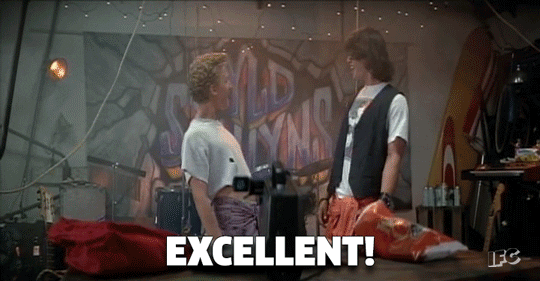
157 notes
·
View notes
Text
A deep dive into AO3 stats
I was feeling a bit bored today, so I decided to create something awesome for myself!
Some of you might already know that I work in data analytics, and I’m not sure if everyone realizes this, but you can actually connect MS Excel Power Query to AO3 to sync your stats and perform in-depth analysis—far beyond what AO3’s built-in stats offer.
My stats aren’t exactly impressive since I only joined the fandom six months ago, but here’s a glimpse of the kind of insights you can generate with this setup:
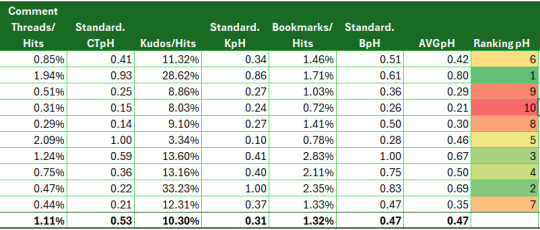
I analyzed reader engagement with my fics by calculating the percentage of people who comment, leave kudos, or bookmark each fic relative to the total number of hits it received. This gave me three measures of engagement: Comment Threads per Hit (CTpH), Kudos per Hit (KpH), and Bookmarks per Hit (BpH).
To avoid skewed results caused by differences in scale across these measures, I standardized them. I did this by dividing each value by the maximum value in its column, which normalized the data and made the metrics comparable. These standardized values were then combined to calculate an Average Engagement per Hit (AVGpH) for each fic. This single metric allowed me to rank my fics from best to worst based on overall engagement per reader.
Here’s the surprising part: my best-performing fic in terms of engagement isn’t my most kudosed one (ranked 4th), nor is it the most commented (ranked 2nd), or the most bookmarked (ranked 8th). This highlights that pure volume of kudos, comments, or bookmarks doesn’t always reflect the quality of reader engagement relative to the fic’s visibility (hits). Instead, it’s the balance across all three engagement types that determines which fic truly resonates most with readers.
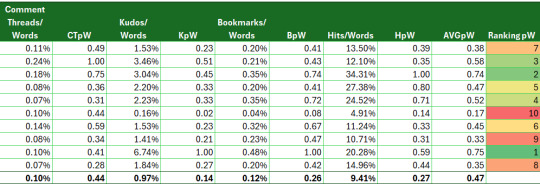
I also analyzed my stats per word to see how the length of my fics influences engagement. While it’s still early to draw definitive conclusions—especially since my longest fic is still a work in progress (I’ll definitely revisit the stats once it’s finished!)—there are already some interesting patterns emerging.
By breaking things down into metrics like Comments per Word (CTpW), Kudos per Word (KpW), Bookmarks per Word (BpW), and Hits per Word (HpW), I could compare how readers interact with fics of different lengths. I combined these into an Average Engagement per Word (AVGpW) to rank my fics by their engagement efficiency.
Key Takeaways
Shorter fics tend to have higher engagement per word. Some of the shorter fics perform exceptionally well, with high Hits per Word and strong kudos and bookmarks per word. On the other hand, longer works show diluted engagement per word, likely because their length makes them a bigger commitment for readers.
Balanced fics perform the best overall. Fics with solid kudos, bookmarks, and hits per word are ranked as the most engaging across the board.
Length affects engagement differently. Shorter or mid-length fics often generate more impact per word, likely because they’re easier for readers to consume quickly. Longer works, while attracting more total engagement, tend to have lower per-word metrics, likely due to their scale.
My top-ranked fic in terms of engagement per word is, interestingly, the one with the most kudos. However, it also has the fewest comments! It’s ranked 7th for bookmarks and has the lowest number of hits among all my fics.
I’m curious to see how these trends shift once my longest fic is complete—it’s a factor that could change these results significantly. For now, though, this analysis highlights how length can influence the way readers engage with your work!
20 notes
·
View notes
Note
Hi Argumate! I just read about your chinese language learning method, and you inspired me to get back to studying chinese too. I want to do things with big datasets like you did, and I am wondering if that means I should learn to code? Or maybe I just need to know databases or something? I want to structure my deck similar to yours, but instead of taking the most common individual characters and phrases, I want to start with the most common components of characters. The kangxi radicals are a good start, but I guess I want a more evidence-based and continuous approach. I've found a dataset that breaks each hanzi into two principle components, but now I want to use it determine the components of those components so that I have a list of all the meaningful parts of each hanzi. So the dataset I found has 嘲 as composed of 口 and 朝, but not as 口𠦝月, or 口十曰月. So I want to make that full list, then combine it with data about hanzi frequency to determine the most commonly used components of the most commonly used hanzi, and order my memorization that way. I just don't know if what I'm describing is super complicated and unrealistic for a beginner, or too simple to even bother with actual coding. I'm also not far enough into mandarin to know if this is actually a dumb way to order my learning. Should I learn a little python? or sql? or maybe just get super into excel? Is this something I ought to be able to do with bash? Or should I bag the idea and just do something normal? I would really appreciate your advice
I think that's probably a terrible way to learn to read Chinese, but it sounds like a fun coding exercise! one of the dictionaries that comes with Pleco includes this information and you could probably scrape it out of a text file somewhere, but it's going to be a dirty grimy task suited to Python text hacking, not something you would willingly undertake unless you specifically enjoy being Sisyphus as I do.
if you want to actually learn Chinese or learn coding there are probably better ways! but I struggle to turn down the romance of a doomed venture myself.
13 notes
·
View notes
Text
yesterday I had a meeting with my future boss to go over an issue I asked the whole sales dept to work on cause it was causing customer-facing data problems.
explaining the multiple root causes of everything that led to this one issue felt like describing a negative skill tree. as in, here're all the branching points of failures these guys have been earning over the years to continuously do their jobs dumber and worse.
convo went:
salespeople either do not adequately manage their customers' inventories or don't attempt managing them.
salespeople either do not create processes, do not document processes, or do not train others to follow processes.
salespeople do not understand how to format csv file downloads to begin managing inventory unassisted. their overall knowledge of excel is frighteningly limited.
salespeople do not communicate problems or needs when they do not have the skills or tools to resolve problems effectively on their own. instead, they choose to act on impulse without fundamental understanding of how their actions might impact anything.
salespeople intentionally misuse editable attribute fields in our system to suit their random one-off needs, creating bad data.
salespeople have created such an incredible amount of bad data (and continue to do so) that many basic filters are completely unusable.
salespeople do not understand (or care) how bad data affects other parts of our system.
salespeople have far too many permissions to edit critical data in our system.
the combination of salespeople's wide range of permissions and lack of processes (or just plain inconsiderate behavior) allows them to circumvent critical checks and balances (and I've caught them doing this shit before).
salespeople have been allowed to show blatant hostility for so long that it is impossible to bring issues to their attention and have those issues resolved. they refuse to work toward solutions if they feel slighted.
I could go on.
22 notes
·
View notes
Text
@hungarianmudkip69 recently asked @vaspider about the spread of HIV. The excellent discussion there focused largely on qualitative aspects, notably what was going on socially in the 1970s and 80s, HIV's subtlety and long incubation periods, and exponential growth (along with a great refutation of accidental needle sticks as a dominant vector).
I've got a math and physics background - I have some extremely relevant intuition, but I still prefer being able to find real-world numbers to confirm that I haven't misapplied it. I encourage checking out all the links in this post; there's a lot of great information!
We can't literally go back in time and test everyone for HIV, but it is possible to model and estimate, e.g. this 2021 report from the CDC (US-only).
The second graph of figure #2 is very close to what we discussed:

(MMSC is male-to-male sexual contact and IDU is injection drug use; see the article for other details.)
Again, these are estimates, so we can't take the exact numbers as fact, but let's look at the big picture. HIV likely first arrived in the US around 1970; it first gained public attention in 1981, when the CDC reported cases of what we now call AIDS. At that point, the estimate is an order of magnitude of tens of thousands of HIV infections.
The original asker was interested in the behavior of a "patient zero" (see also "Debunking the Myth of Patient Zero", an excellent video linked in that thread). These numbers help us see how little effect one hypothetical person's behavior could have had on the end result. As long as the virus was transmitted at all, it was going to reach the highest-risk populations eventually, and spread once there, whether it took one hop or ten. It was also essentially impossible to notice the pattern and infer the existence of HIV/AIDS in the US until multiple people in the same community developed AIDS and contracted unusual infections - which most likely means that it's reached that high-risk population, and ten years have passed.
Tens of thousands of infections is simply the result of exponential growth during those ten years; stopping it from becoming an epidemic would've required everyone's behavior to have changed. Different behavior, different transmission, different number of hops early on would more likely have changed how long it took to spread widely enough to become noticeable, not whether it did. (An unfortunately familiar concept, in the year 2023.)
The authors also mention that "trend data comparing subpopulations is likely to be robust for each period examined", so let's look back at those individual lines. Injection drug use (IDU) actually was a fairly significant means of transmission by the 1980s, and by the mid-80s, the spread among gay/bi men (MMSC) was beginning to decline. At the end of the decade, IDU may even have passed MMSC. Simultaneously, transmission was still rising among straight people. It shouldn't be too surprising that straight sex became significant; there are rather a lot of straight people!
The CDC also has us covered for a more current picture, as of 2017-2021 in the US:

This does vary greatly by country. Notably, as of 2022 in England, 49% of new diagnoses were among heterosexuals, compared to 45% among gay/bi men. (Do keep in mind that there are far more straight people, so still, a far higher fraction of gay/bi men were diagnosed.)
I personally find that I get the best understanding when I'm able to combine some direct evidence/data with an understanding of the history and social forces; hopefully this piece helps at least one person out in that way!
[Finally, as a footnote: trans women also exist (hi I'm one) and have historically been at high risk. I am unsure to what extent trans women are omitted versus misgendered in the above data. I wanted to focus on historical estimates over time here, and unfortunately wasn't able to find that for trans women, but this review article links to and summarizes some data from two meta-analyses.]
126 notes
·
View notes